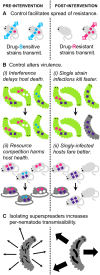Evolutionary consequences of feedbacks between within-host competition and disease control
- PMID: 32099654
- PMCID: PMC7027713
- DOI: 10.1093/emph/eoaa004
Evolutionary consequences of feedbacks between within-host competition and disease control
Abstract
Lay Summary: Competition often occurs among diverse parasites within a single host, but control efforts could change its strength. We examined how the interplay between competition and control could shape the evolution of parasite traits like drug resistance and disease severity.
© The Author(s) 2020. Published by Oxford University Press on behalf of the Foundation for Evolution, Medicine, and Public Health.
Figures

References
-
- Mideo N. Parasite adaptations to within-host competition. Trends Parasitol 2009;25:261–8. - PubMed
LinkOut - more resources
Full Text Sources

